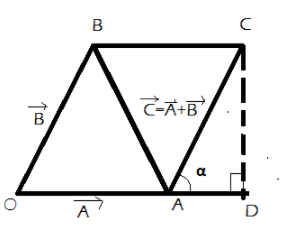Question
Question: Find the magnitude and direction of the resultant of two vectors \[A\] and \[B\] in terms of their m...
Find the magnitude and direction of the resultant of two vectors A and B in terms of their magnitudes and angle θ between them.
Solution
In order to solve this question, we are first going to consider the two vectors, and consider the magnitudes for them. Now, we will consider the parallelogram with the two vectors A and B, and the resultant is given by the diagonal of the parallelogram. Then, the magnitude and direction of the resultant are found.
Formula used:
The Pythagoras theorem is given by,
OC2=CD2+DO2
Where, OC is the hypotenuse, CD and DO are base and perpendicular.
Complete answer:
It is given that there are two vectors A and B, such that their magnitudes are
\left| A \right| = a \\\
\left| B \right| = b \\\
The angle between them is θ
So, if the resultant of these two vectors is taken as C
Then,
A+B=C
Now, to find the magnitude and the direction, consider the parallelogram OABC with D as the foot of the perpendicular as shown in the figure

Now, in triangle OCD, if we apply the Pythagoras theorem,
OC2=CD2+DO2
Solving this further, we get
OC=OA2+AD2+2⋅OA⋅AD+CD2
Putting the values,
OC=a2+b2+2⋅a⋅bcosα
Where,AD=ACcosα=bcosα
Thus, the magnitude of the resultant vector is
c=a2+b2+2abcosα
Now, finding the direction, we get
Given that C makes an angle θ with A,
θ=tan−1(a+bcosαbsinα)
Hence, the magnitude and direction of the resultant are given by
c = \sqrt {{a^2} + {b^2} + 2ab\cos \alpha } \\\
\theta = {\tan ^{ - 1}}\left( {\dfrac{{b\sin \alpha }}{{a + b\cos \alpha }}} \right) \\\
Note: It is important to note that the triangular law of addition has been applied in this question, for the vectors A and B,
A+B=C
According to the triangle law of vector addition:
Triangle law of vector addition states that when two vectors are represented as two sides of the triangle with the order of magnitude and direction, then the third side of the triangle represents the magnitude and direction of the resultant vector.
